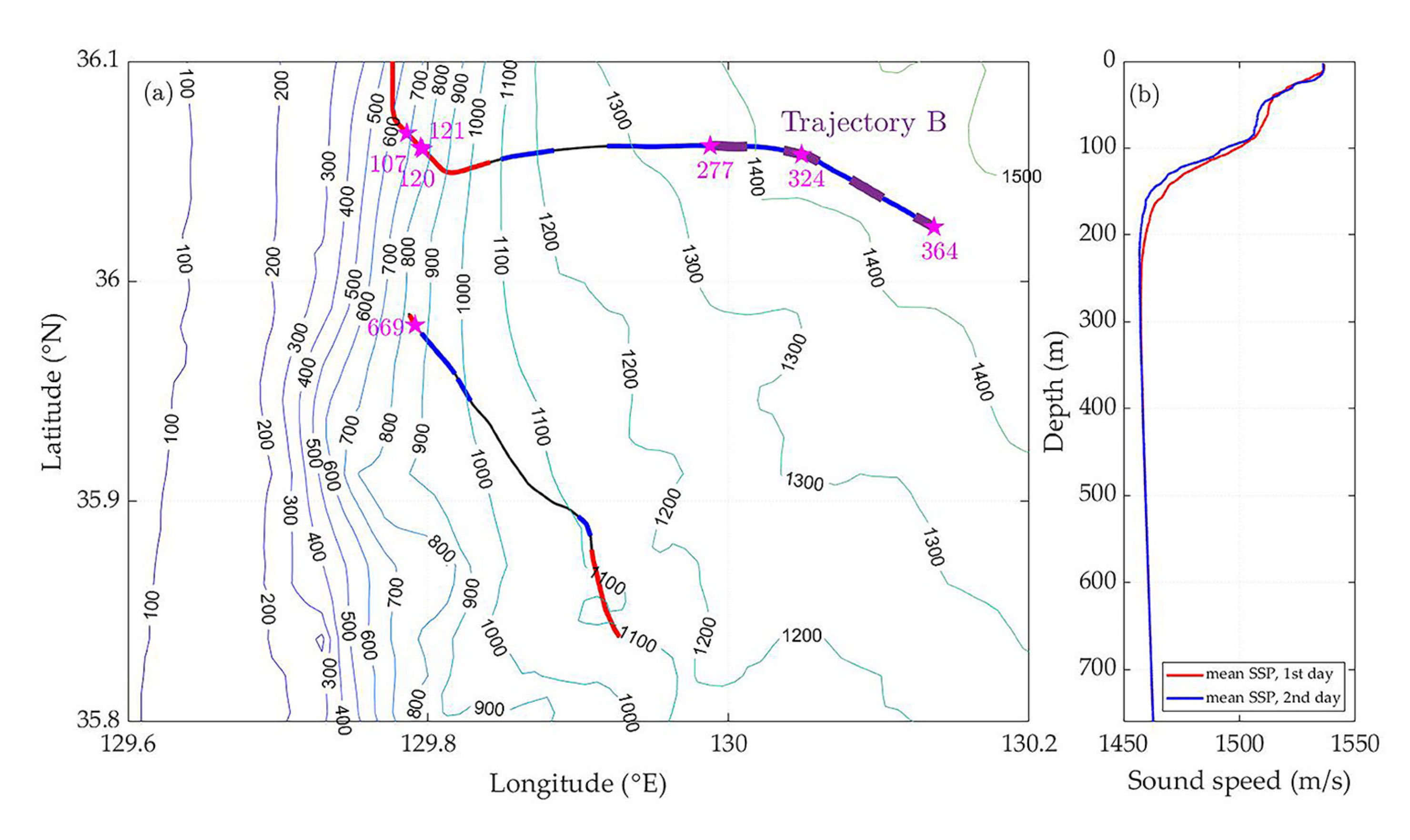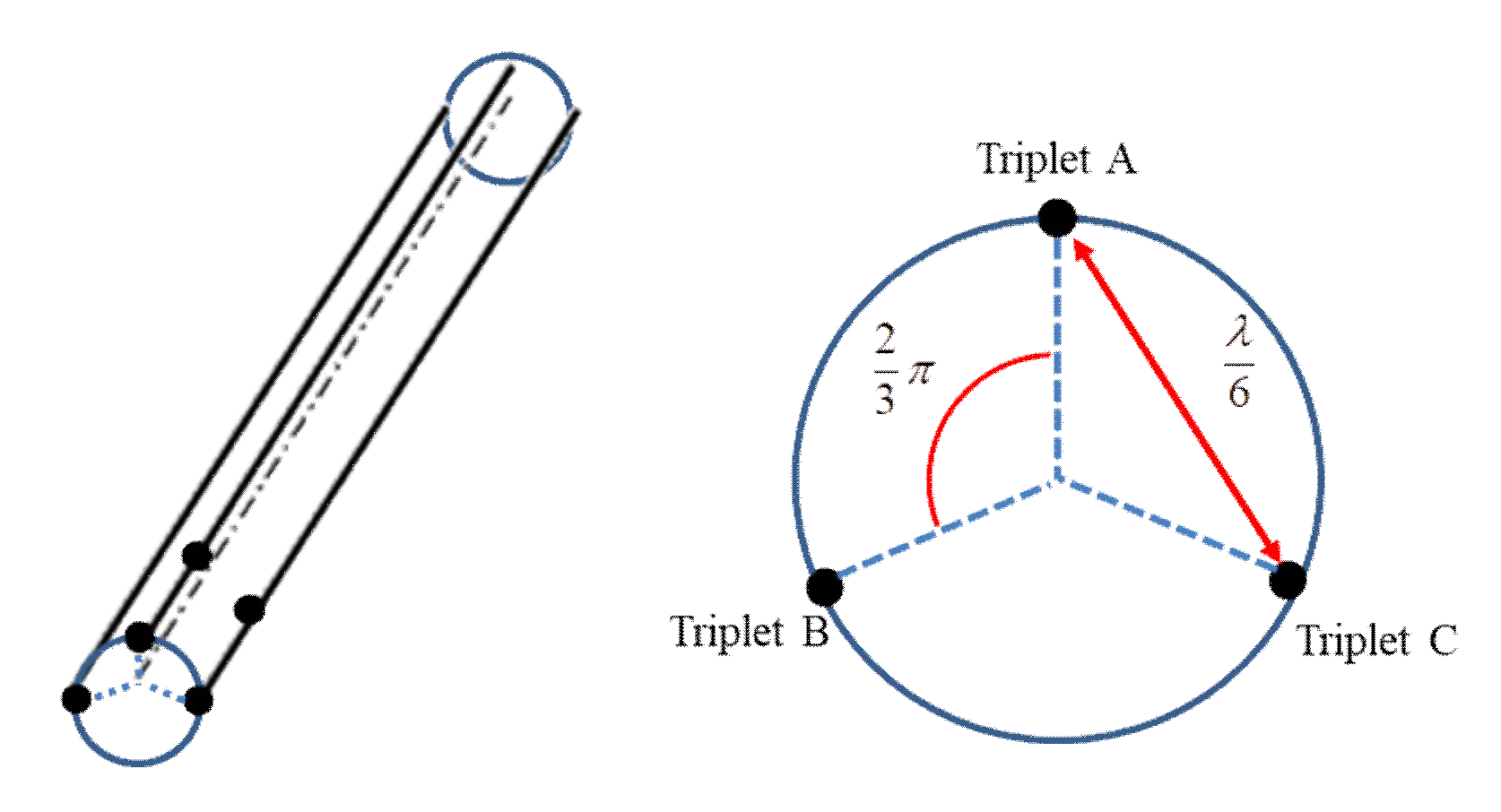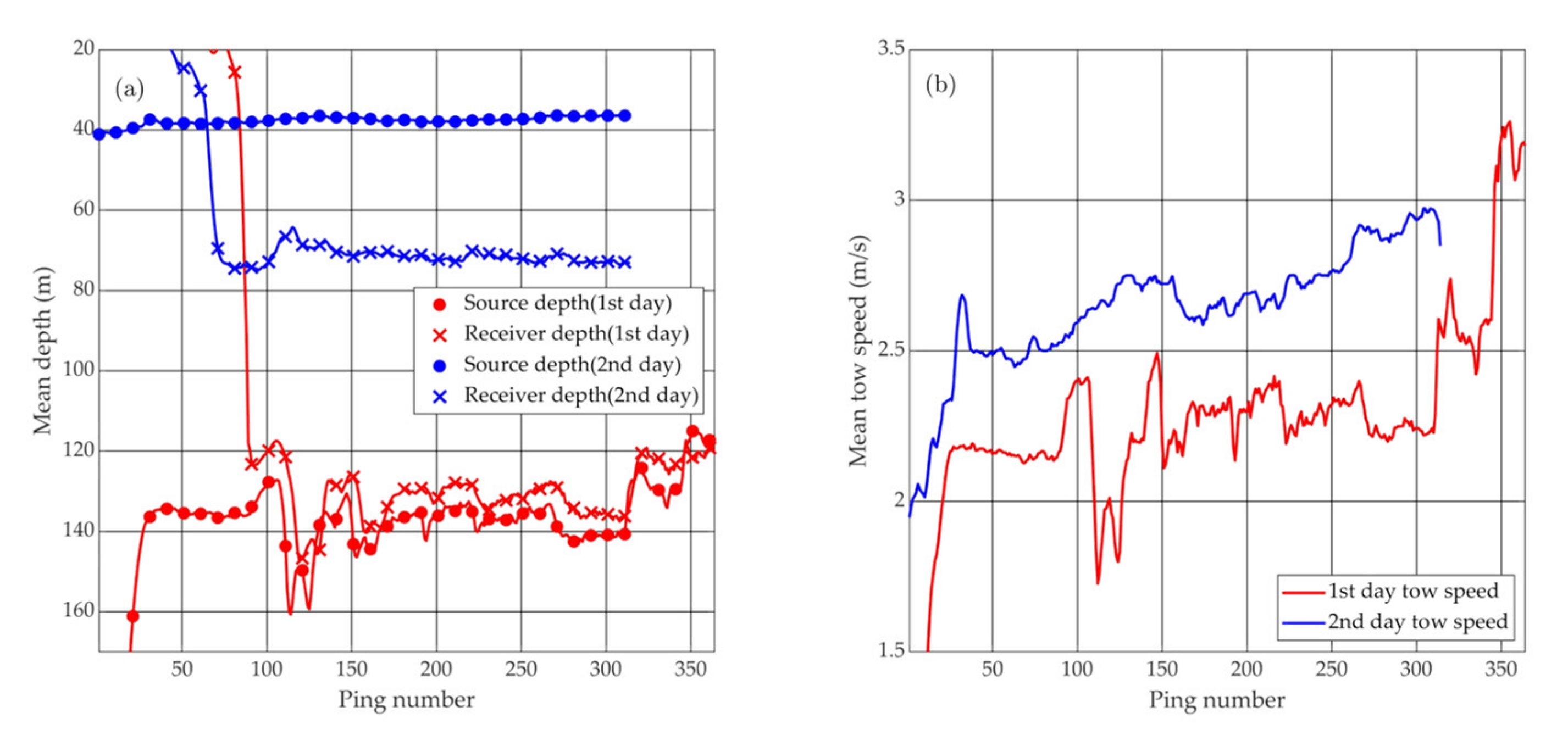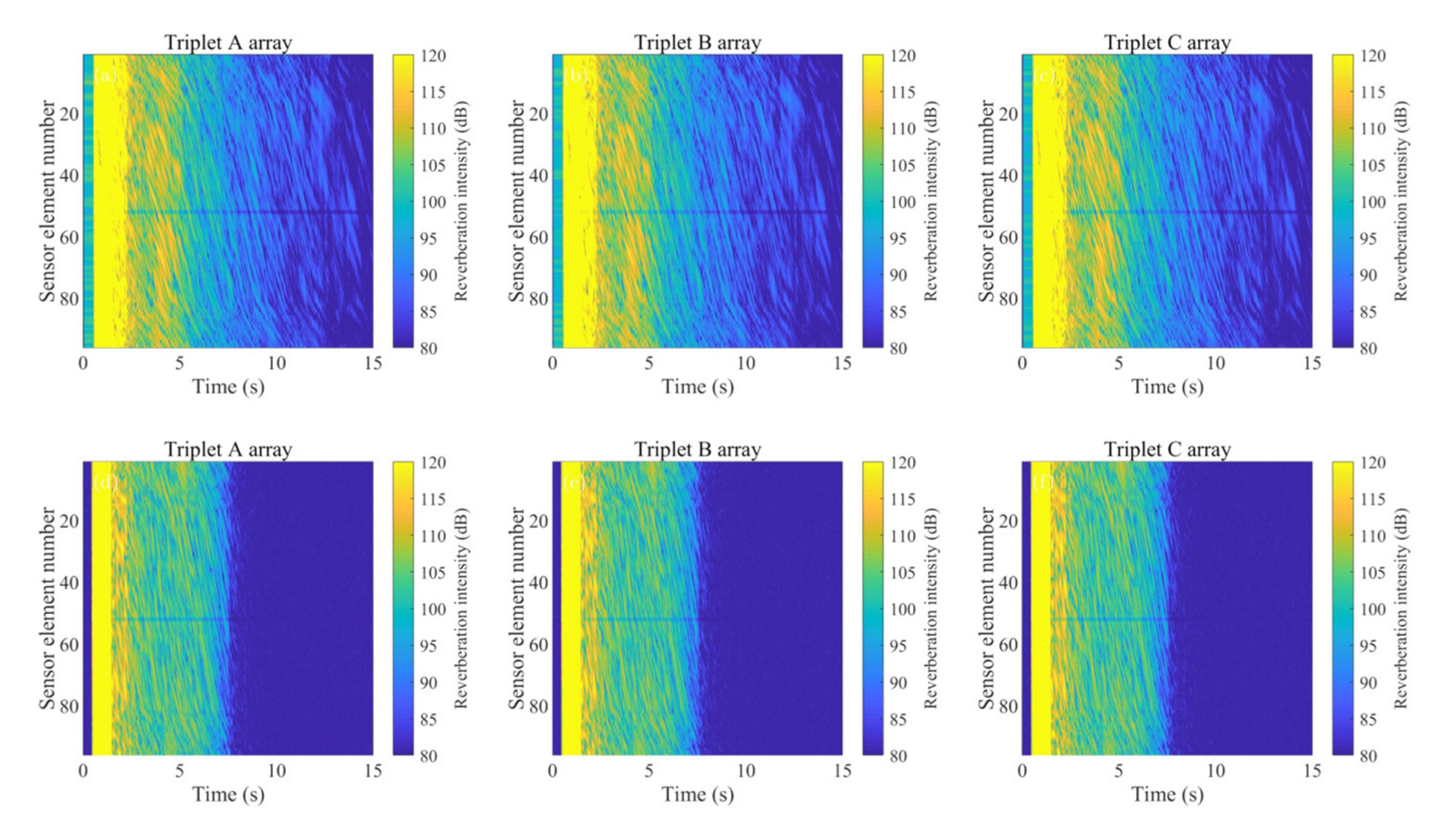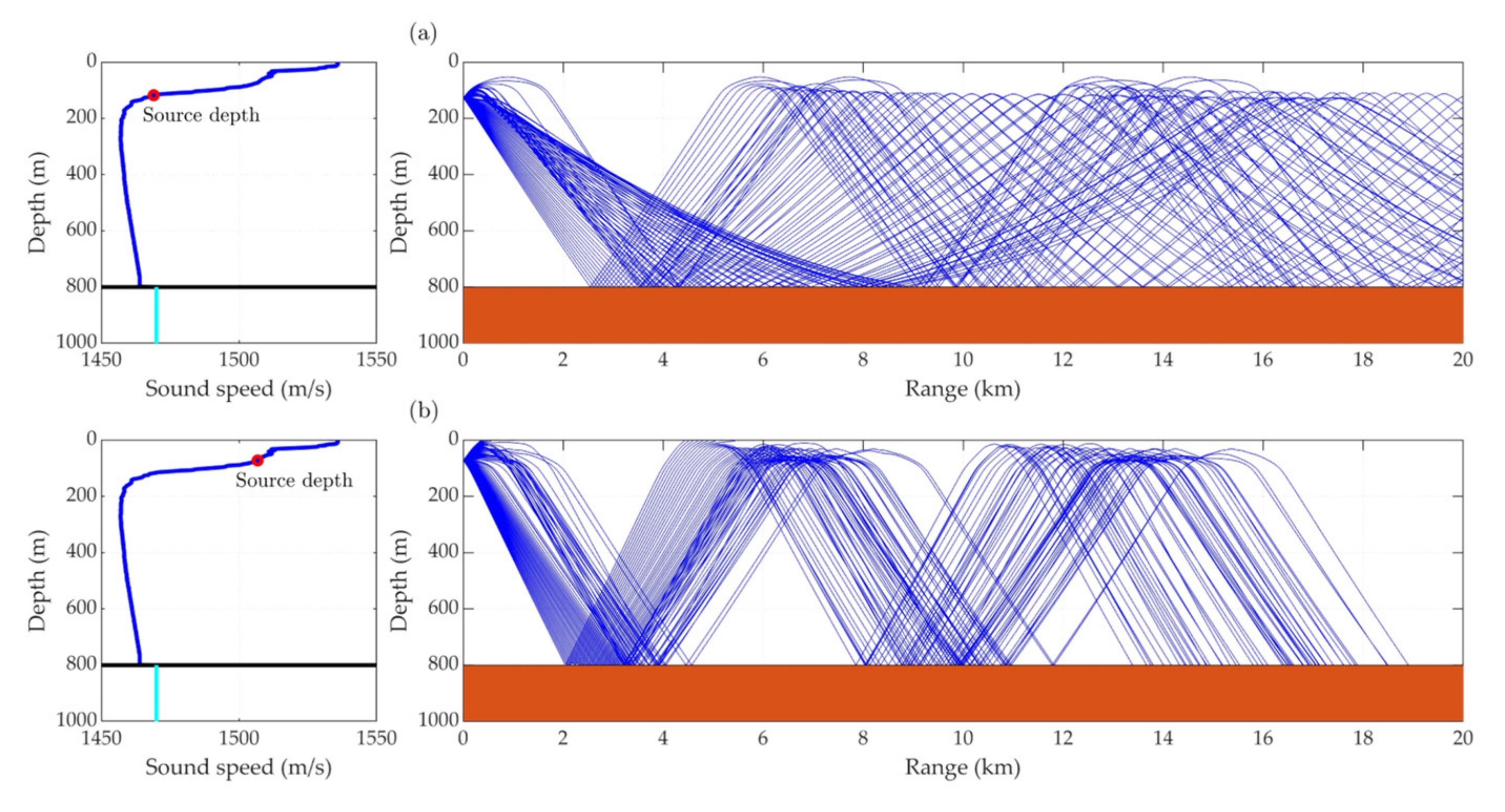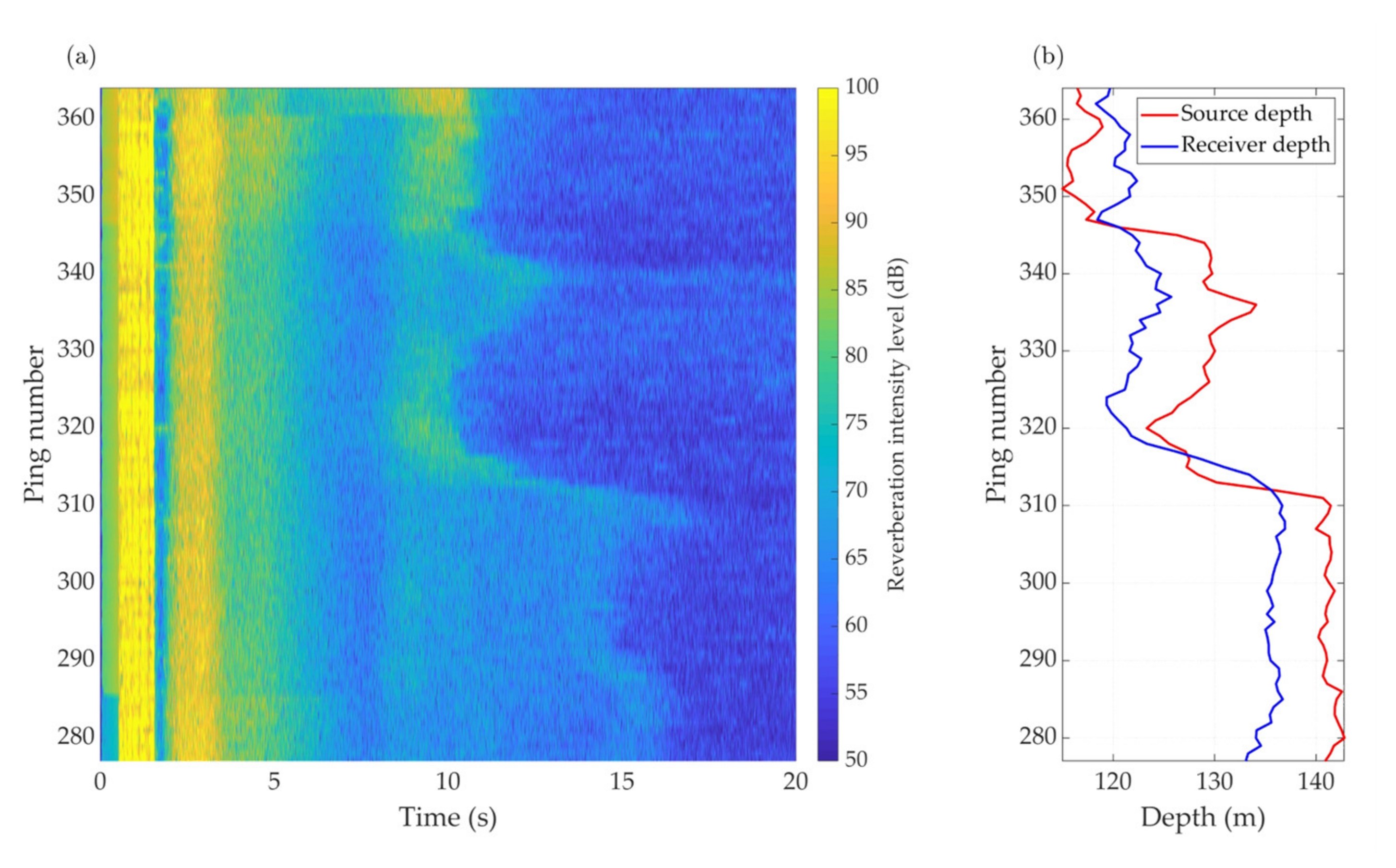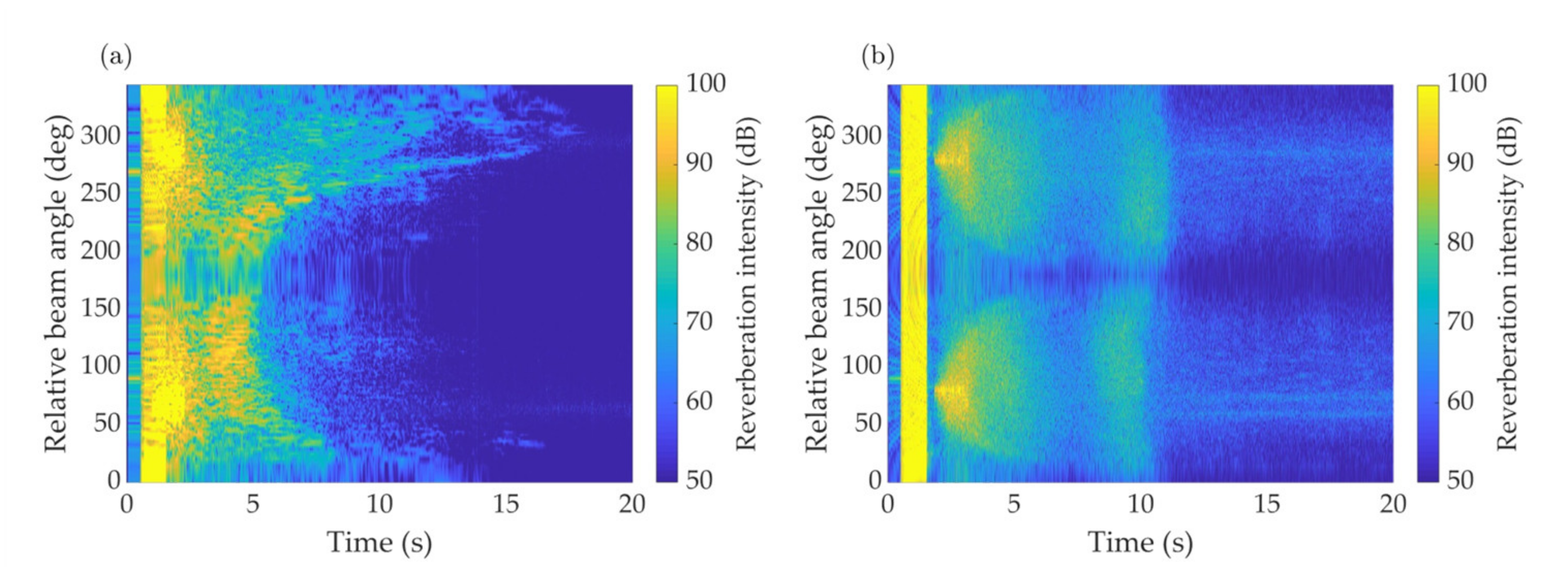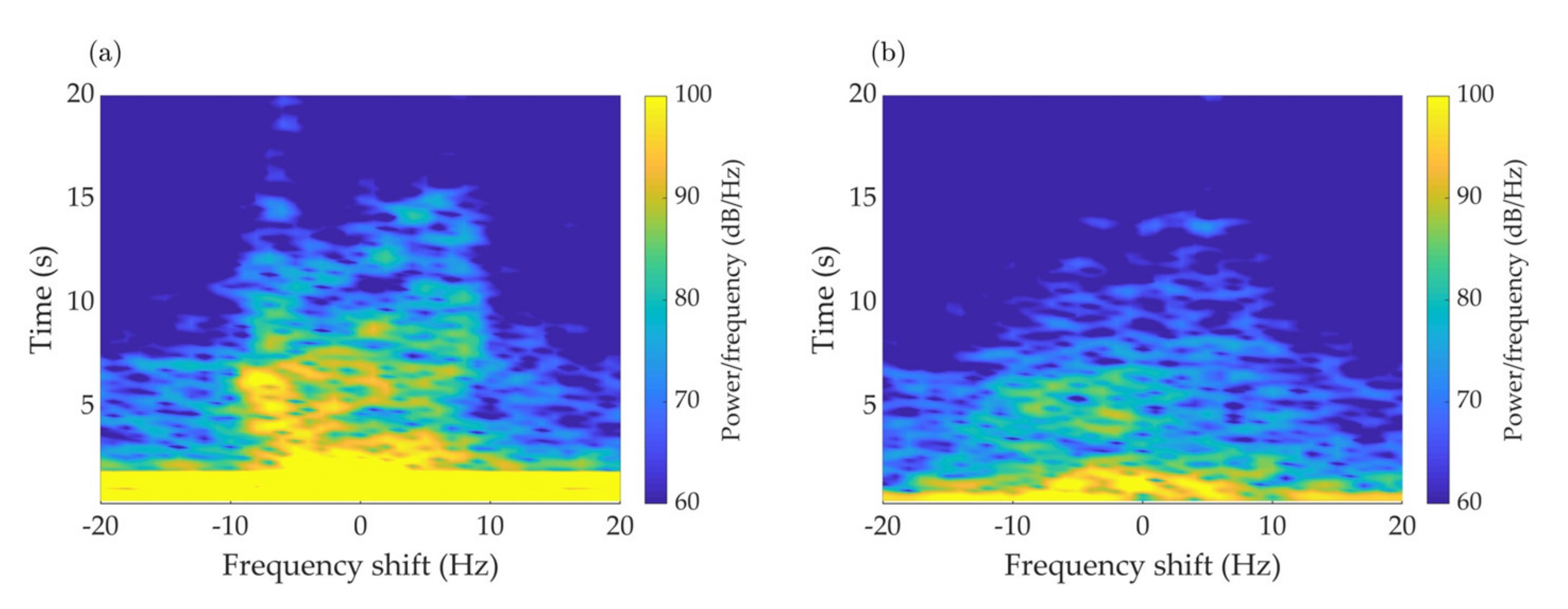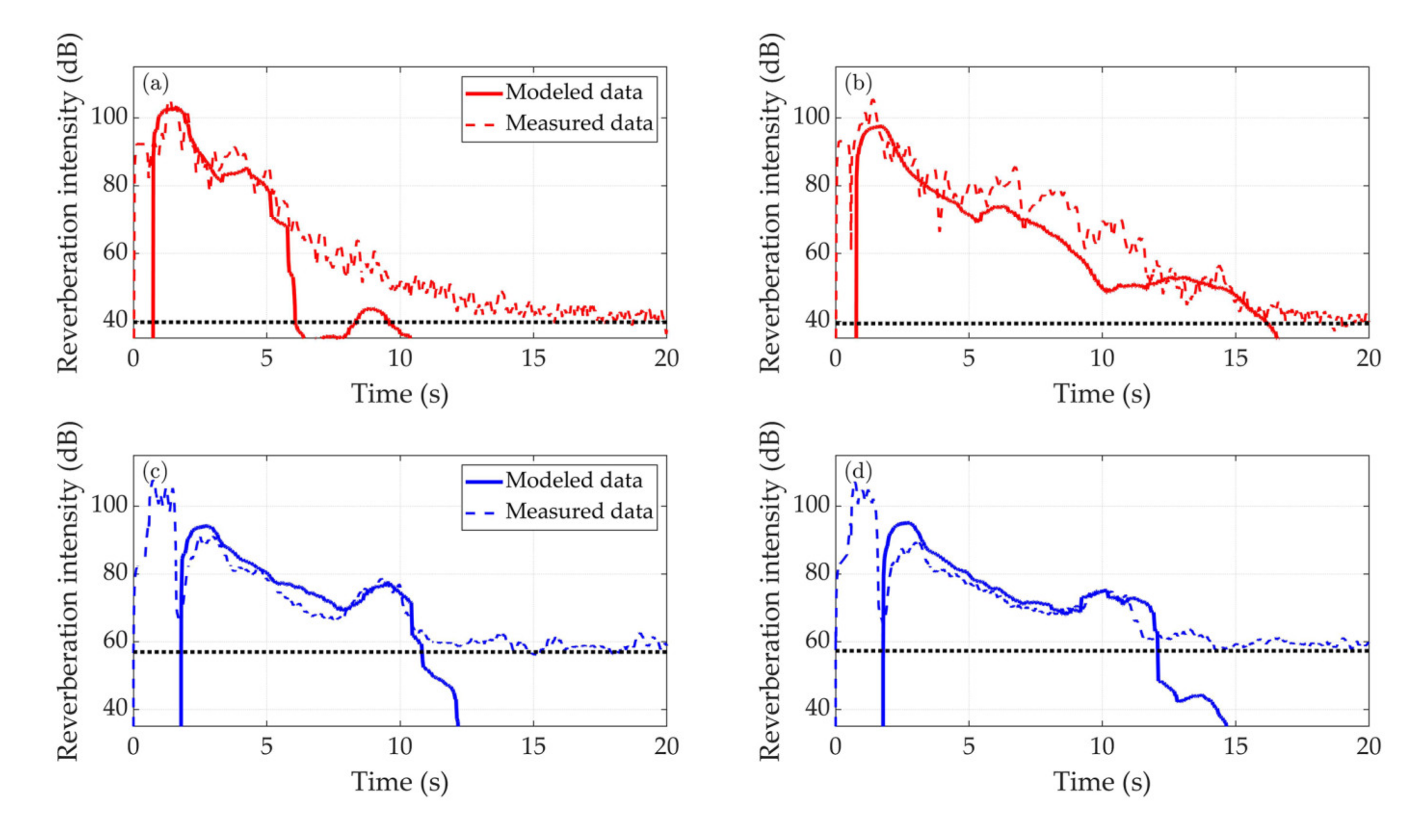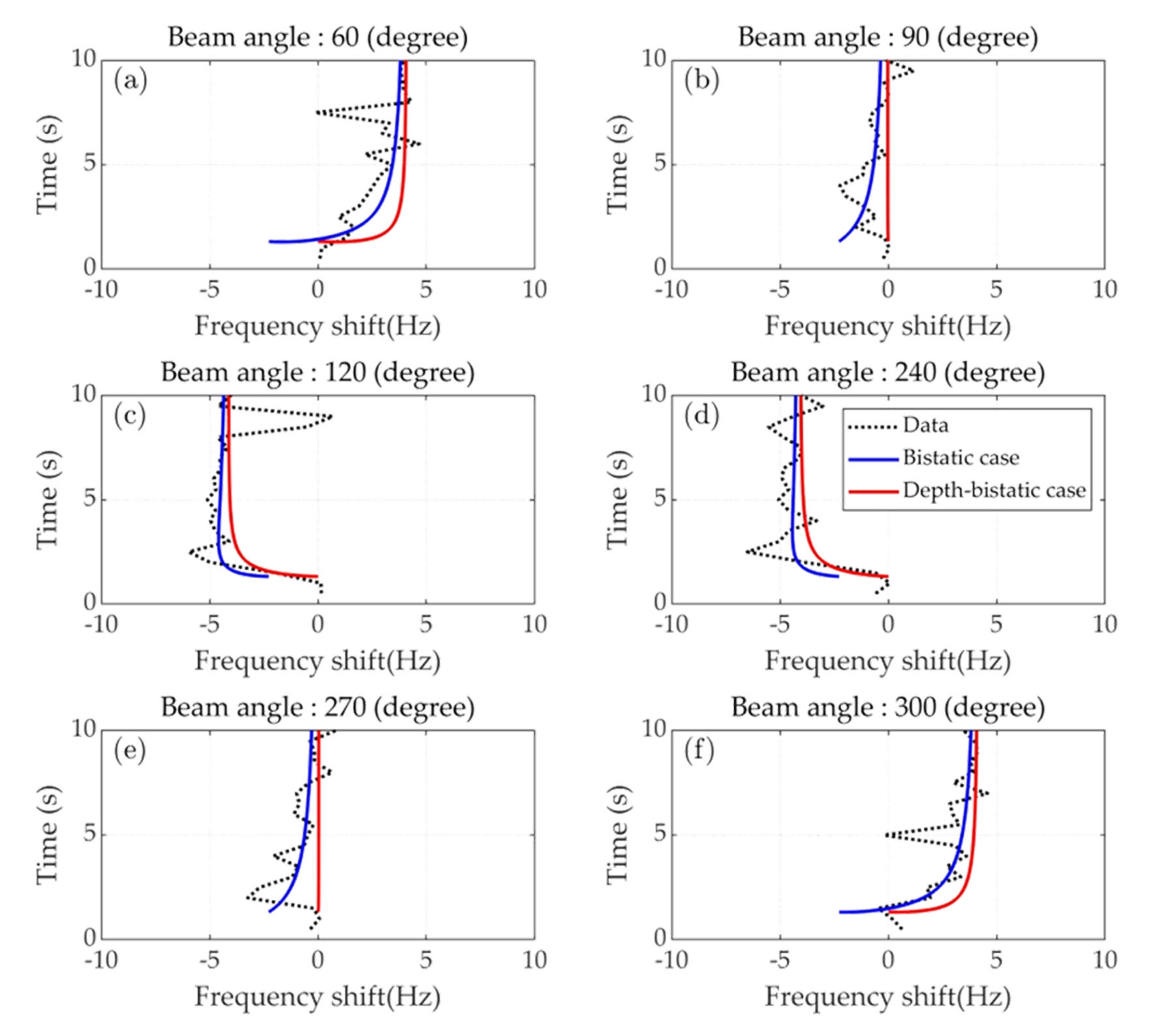1. Introduction
Ocean reverberation is generated by the scattering mechanism of ocean boundary irregularities and medium inhomogeneities [
1] and is one of the dominant environmental factors that have to be considered in the design of active sonar systems [
2,
3,
4,
5].
Since the 1940s, there have been many studies on the prediction of reverberation in the ocean [
6,
7,
8,
9]. These studies can be categorized in a variety of ways, e.g., physics of scattering, coherence, scattering modeling, propagation modeling, and geometry of sources and receivers. In terms of propagation modeling, reverberation models are usually classified into energy flux models [
10,
11], ray-based models [
12,
13,
14,
15], normal mode models [
16], and parabolic equation models [
17]. Among them, the ray-based model is known to be well-suited for reverberation modeling of the complex ocean environment in the frequency range of 1 to 10 kHz.
The numerical burdens of reverberation modeling are generally high because the modeling is performed with the repetitive usage of the propagation model and the scattering model along each scattering element of a physical domain [
15]. In the case of bistatic sonar, where the source and receiver are separated by a distance, the numerical burden will be even higher, because out-of-plane scattering is included in the calculation [
18]. However, such a rigorous approach may be unnecessary for an active towed array where the distance between the source and receiver is not large (<1 km).
In this study, we extend the 2D geometrical ray-bundle reverberation model for the fixed mono-static sonar [
14] to a 3D environment with the approach and develop a depth-bistatic bottom reverberation model for an active towed array composed of a variable depth source and a triplet line array. This model neglects out-of-plane scattering in the sea floor but allows for bistatic Doppler shift, which is simplified as a straight-line propagation between a moving source, a moving receiver, and fixed scatterers. A major advantage of this depth-bistatic scheme is that it can reduce the computational costs. The fully bistatic scheme basically requires two independent ray-bundle (or ray-beam) tracings for a bottom cell because the source and receiver is located on the out-of-plane, while the depth-bistatic scheme uses one ray-bundle tracing in a plane where the bottom cell, the range, and the receiver are located. When the distance between the source and receiver is small, the latter has the similar accuracy as the former in the long-range reverberation.
Moreover, we confirm the validity of the proposed model using mid-frequency reverberation data [
19] collected in the East Sea of Korea during August 2015 by the Agency for Defense Development of Korea. These data are valuable in two aspects. One aspect is that they were obtained with a variable depth source in the mid-frequency range of 2 to 4 kHz in a deep-water environment. Another aspect is to use the triplet array, which can resolve the left/right ambiguity [
20,
21]. This enables a detailed analysis of a coherent reverberation signal in the azimuth. Note that the state-of- the-art reverberation experiments are well described by Yang et al. in [
9].
This paper is organized as follows:
Section 2 describes a depth-bistatic bottom reverberation model with a moving source and receiver for a complex bathymetry. In
Section 3, an overview of our reverberation experiment and the signal processing method are presented. Some observations for the azimuth and the operation depths from the measured data are described.
Section 4 includes the model-data comparisons. Finally,
Section 5 contains a summary and conclusions.
2. Depth-Bistatic Bottom Reverberation Model
The active towed array system of this study consists of a depth variable source and a triplet line array, operated with cable in a research vessel. The operation depths of the source and receiver arrays can be controlled by the ship speed and the employed cable length. The geometry of this array is nominally considered bistatic. However, the range between the source and receiver arrays in our system is usually within 1 km. This small range suggests the applicability of the depth-bistatic model, which takes into account that the source and receiver are collocated in range but separated in depth, in order to predict the reverberation of an active towed array.
Reverberation in the ocean is expressed as the sum of the time signals scattered from the randomly distributed scatterers in volume and boundary. It means that the reverberation signal is essentially a random process. To model a random pressure signal directly is numerically expensive and meaningless. Thus, a heuristic approach for modeling the ensemble-averaged intensity signal has been widely used in the underwater acoustics community [
22].
We consider an
N × 2
D ocean environment with a depth-bistatic geometry of the source and receiver, as shown in
Figure 1. Assuming the positions of the source and receiver are fixed, the impulse response of the incoherent bottom reverberation for the
i-th bottom cell is formulated with the approach of [
14] as the following equation:
where
is the azimuthal interval, the subscripts n and m indicate the eigenray index from the source to the scatterer and from the scatterer to the receiver, respectively,
and
are the propagation losses and the time delays for a one-way path, respectively, and
is the bottom scattering cross-section as a function of the incident angle
and the scattered angle
. In addition,
is defined as
with a range interval
and a sound speed
near the bottom.
is a rectangular function defined as 1 inside −1/2 to 1/2 and 0 outside it. Note that Equation (1) is called the ensemble-averaged impulse response.
To account for Doppler effects resulting from the motions of the source and receiver, we apply a Doppler shift obtained from the straight-line propagation between the source, receiver, and the
i-th bottom cell into Equation (2). The Doppler angular frequency is written as:
where
is the original angular frequency of the transmitted waveform,
and
are the sound speeds in the receiver and the source positions, respectively, and
and
are the velocities of the receiver and the source relative to the
i-th scatterer, respectively. Here,
and
are the unit vectors in the direction of the receiver to the
i-th scatterer and in the direction of the source to the scatterer, respectively. For example, supposing that the source position is
, the receiver position is
, and the scatterer position is
;
and
are defined as
and
, respectively.
If the Doppler angular frequency within a bottom cell is stationary during the pulse duration, the Doppler-shifted impulse response can easily be calculated with Equation (2) as
where:
Equation (3) is the Doppler-shifted impulse response at the 2D cell of the bottom bathymetry for a moving depth-bistatic array. However, it turns out that a direct use of Equation (3) does not work well for efficient reverberation modeling. This is because the Doppler angular frequency is truly stationary in a bottom cell with a small range step of . To solve this problem, we apply an interpolation method for Doppler modeling. First, the values of in all bottom cells along the range in an azimuthal slice are calculated using Equation (4). Then, the linear interpolation is used to generate new samples between the original values of using the sampling frequency of the reverberation signal. With this procedure, the within a bottom cell becomes time varying, which increases the accuracy of Equation (3) even for a large range step.
The total reverberation signal is defined according to the intensity of the source pulse
as:
Here, the summation index i indicates the number of the bottom cell, and the indexes of n and m are the number of incident and scattered eigenrays at the i-th bottom cell, respectively.
4. Model/Data Comparison
A comparison of the modeled data and the measured data is shown in this section. For the reverberation modeling, the empirical Lambert’s law scattering function with kernels [
25] was used as given by:
where
is the empirical Lambert’s coefficient and
p and
q are scattering kernels. We set Lambert’s coefficient
to be −40 dB for CW and −37 dB for LFM. Two scattering kernels are chosen to be 0.5 through data fitting. The sea-floor bathymetry is created using the General Bathymetric Chart of the Oceans (GEBCO) with a 15 arc-second resolution grid (~450 m) [
26]. The properties of the ocean bottom are obtained from the geological database of the co-located sediment coring. The sound speed of the surficial sediment is 1470 m/s, its density is 1200 kg/m
3, and the attenuation coefficient is 0.08 dB/λ, which corresponds to silt-clay sediment. The bottom is regarded as a homogeneous half-space. Finally, for a realistic simulation, the ambient noise signal of a white Gaussian noise type is added to the sensor data.
Figure 11 shows the modeled reverberations of ping 107 and 324, described in
Section 3. The results of
Figure 9 and
Figure 11 show very similar features. In
Figure 11a, a longer reverberation time is observed for the downslope direction than for the upslope direction. To examine this feature precisely, the beam time series shown in
Figure 11a is sliced at starboard and port, which corresponds to the upslope and the downslope directions, respectively.
Figure 12 shows the results. To remove the random fluctuation of the reverberation, the measured data were time-averaged with the window of 0.06 s. The dotted line indicates a noise floor of 40 dB and 60 dB, respectively. In the starting region of measured data, ghost signal is observed by the electric coupling of source and receiver array. After about 0.5 s, the direct blast is arrived. We note again that the time signal with a large voltage are clipped. For the case of ping 107 that the water depth is shallower, it is seen that the direct blast is mixed with multi-path signals and reverberation signals. Totally, the modeled results (solid line) agree well with the measured results (dashed line), except that a longer tail appears in the latter. This tail may be a consequence of the scattering from sea-floor layering or volume inhomogeneity.
In
Figure 13, the modeled spectrogram for the CW with the 1 s duration and 3 kHz center frequency is given and compared with the results obtained without the platform motion. The environmental parameters used are the same as for
Figure 11. Comparing
Figure 10a and
Figure 13a, it is clear that our model describes the spectrum broadening well. In
Figure 13b, we can see that the model without Doppler correction fails to predict realistic reverberation.
Finally,
Figure 14 shows the change of the extracted Doppler shift for the motion of the source and receiver arrays using Equation (6). The reverberation data of ping 120 with a 3 kHz center frequency and a 1 s duration is chosen. The extracted Doppler shift fluctuates due to contamination by multi-path scattering at an early time and the time variability of the towed system and environment, while the overall trend is clearly revealed. We compare it with the Doppler shift extracted from the modeled reverberation using Equation (6) again. The red solid line shows the results without a correction of the bistatic geometry, which means that the range of the source and receiver is zero. The blue solid line represents the results with the true bistatic geometry. It can be seen that the use of the bistatic geometry is better for predicting the Doppler shift of the CW reverberation in the active towed array system than that of a depth-bistatic geometry.
5. Conclusions
We have developed an N × 2D bottom reverberation model for the depth-bistatic sonar which is useful for an active towed array system. This model an extension of a previously published geometric ray-bundle reverberation model for a moving, depth-bistatic sonar. The main assumption is to neglect all out-of-scattering between the source, scatterer, and receiver in the bistatic geometry. This is valid when the distance between the source and receiver is small, as in the active towed array sonar system.
With this depth-bistatic model, the reverberation data acquired in the East Sea of Korea with the active triplet towed array system are analyzed. The experimental conditions at the time were favorable for us to obtain high-quality bottom-reverberation data. From the measured data, we first observe the effect of the operation depth on the bottom reverberation in deep water. Second, the beam data analysis shows that the reverberation pattern at an azimuth is strongly dependent on its bathymetry. Moreover, the Doppler broadening and shifting caused by the moving platform can be observed with a time-frequency analysis.
Some of the measured data are compared with the modeled data in the time, frequency, and beam domains. Our model favorably describes the key features observed in the real reverberation data, such as the variability of the reverberation with the operation depth, the bathymetry, the steering direction, and the Doppler effect. One limitation of this study is the lack of consideration for multi-path arrivals in the calculation of the Doppler angular frequency, which is noticeable in the near field reverberation. This factor should be included in future works on the fully bistatic model.

